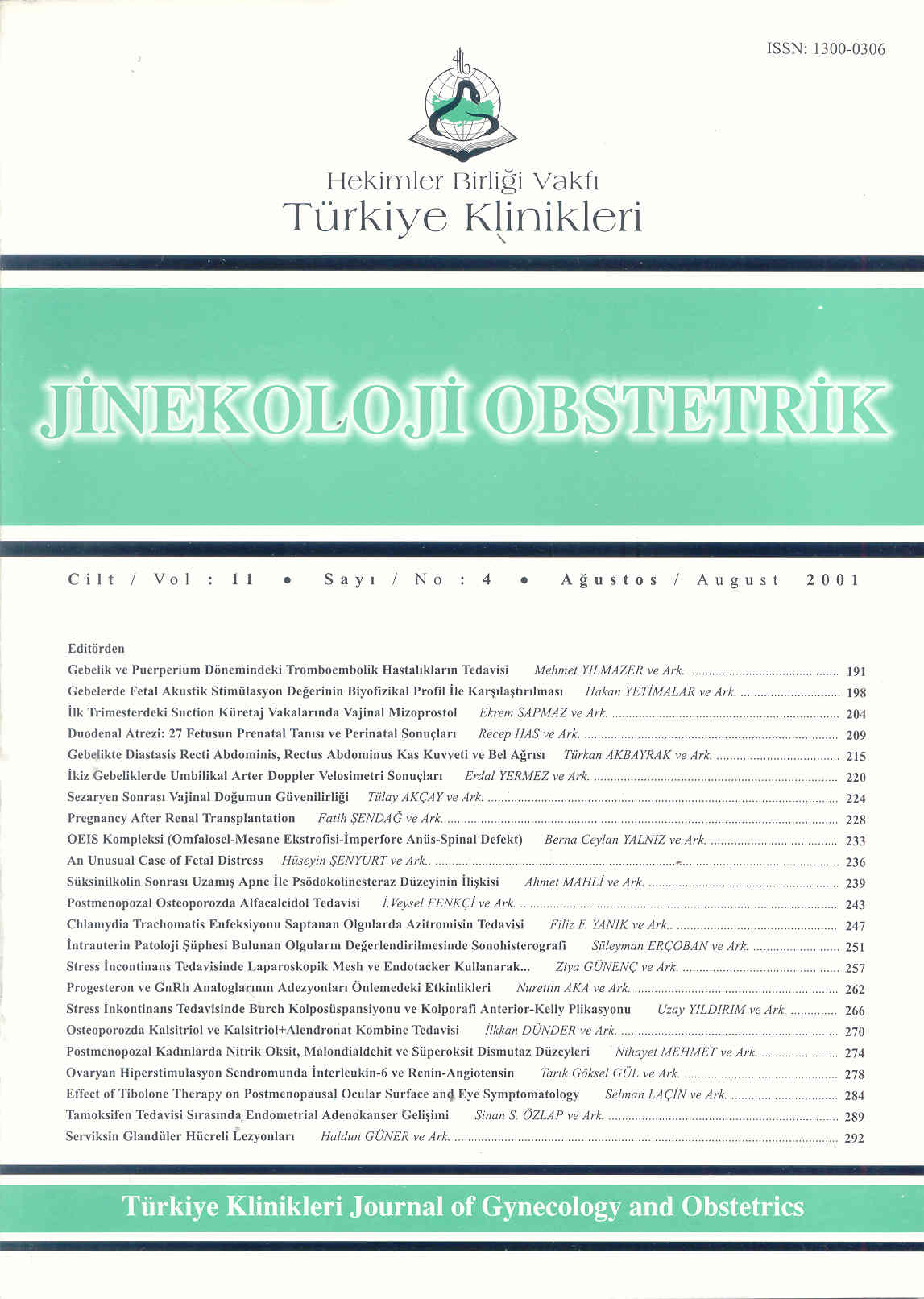Open Access
Peer Reviewed
ARTICLES
3286 Viewed2136 Downloaded
The Comparison Of Biophysical Profile Withfetal Acoustic Stimulation Values In Pregnants
Gebelerde Fetal Akustik Stimülasyon Değerinin Biyofizikal Profil İle Karşılaştırılması
Turkiye Klinikleri J Gynecol Obst. 2001;11(4):198-203
Article Language: TR
Copyright Ⓒ 2025 by Türkiye Klinikleri. This is an open access article under the CC BY-NC-ND license (http://creativecommons.org/licenses/by-nc-nd/4.0/)
ÖZET
Amaç: Bu çalışmada, fetal sağlığın intra uterin değerlendirilmesinde biyofizik profil ve fetal stimülasyon kullanıldı. Fetal akustik stimülasyon ile biyofizik profilin birbiri ile uyumunun araştırılması amaçlandı. Materyel ve Metod: Çalışmaya İzmir Atatürk Eğitim Hastanesi 3. Kadın Hastalıkları ve Doğum Kliniğine başvuran 80 gebe alındı. 83 bebeğe önce biyofizik profil, ardından fetal akustik stimülasyon yapıldı. Elde edilen sonuçlar Fishers Exact Test ile istatiksel olarak analiz edildi ve uyumun cohen Kappa istatistiği ile de rastgele uyum olup olmadığı araştırıldı. Bulgular: Fetal akustik stimülasyon (FAS), biyofizik profil (BFP) ile karşılaştırıldığında, istatistiksel olarak anlamlı derecede uyumlu bulundu. FASın BFP bileşenlerinden non stres test (NST) ve amnion sıvı volümü (ASV) ile olan uyumunda istatistiksel olarak anlamlı olduğu bulundu. FASın ayrıca non reaktif NST yüzdesini azalttığı izlendi. Çalışmaya alınan 26 gebenin travayları takip edilebildi ve doğan bebeklerin 1. ve 5. dakika Apgar skorları yapıldı. Sonuçlar, BFP ve FAS ile verilen yanıtla karşılaştırıldı ve istatistiksel açıdan uyumlu bulundu. Tartışma: Çalışmada akustik stimülasyon testinin BFP ile uyumlu olduğu, testin kolay uygulanabilir olduğu test zamanını kısalttığı, non reaktif test yüzdesini azalttığı sonucu elde edildi.
Amaç: Bu çalışmada, fetal sağlığın intra uterin değerlendirilmesinde biyofizik profil ve fetal stimülasyon kullanıldı. Fetal akustik stimülasyon ile biyofizik profilin birbiri ile uyumunun araştırılması amaçlandı. Materyel ve Metod: Çalışmaya İzmir Atatürk Eğitim Hastanesi 3. Kadın Hastalıkları ve Doğum Kliniğine başvuran 80 gebe alındı. 83 bebeğe önce biyofizik profil, ardından fetal akustik stimülasyon yapıldı. Elde edilen sonuçlar Fishers Exact Test ile istatiksel olarak analiz edildi ve uyumun cohen Kappa istatistiği ile de rastgele uyum olup olmadığı araştırıldı. Bulgular: Fetal akustik stimülasyon (FAS), biyofizik profil (BFP) ile karşılaştırıldığında, istatistiksel olarak anlamlı derecede uyumlu bulundu. FASın BFP bileşenlerinden non stres test (NST) ve amnion sıvı volümü (ASV) ile olan uyumunda istatistiksel olarak anlamlı olduğu bulundu. FASın ayrıca non reaktif NST yüzdesini azalttığı izlendi. Çalışmaya alınan 26 gebenin travayları takip edilebildi ve doğan bebeklerin 1. ve 5. dakika Apgar skorları yapıldı. Sonuçlar, BFP ve FAS ile verilen yanıtla karşılaştırıldı ve istatistiksel açıdan uyumlu bulundu. Tartışma: Çalışmada akustik stimülasyon testinin BFP ile uyumlu olduğu, testin kolay uygulanabilir olduğu test zamanını kısalttığı, non reaktif test yüzdesini azalttığı sonucu elde edildi.
ANAHTAR KELİMELER: Fetal görüntüleme, biyofizik profil, fetal akustik stimülasyon.
ABSTRACT
Objective: In this study we used biophysical profile (BPP) and fetal acustical stimulation (FAS) for predicting fetal health in utero. We aimed to compare the accordance of these two methods. Materials and Methods: 80 pregnant women referring for antenatal care to the Izmir Atatürk Educational Hospital 3rd Clinic of Obstetrics and Gynecology were included in this study. 83 fetuses were screened first with BPP and second with FAS. The results were compared. Results: The accordance of FAS with BPP was found to be statistically significant. Also the accordance of non stress testing (NST) and amniotic fluid volume (AFV) which are members of BPP were statistically significant. We also found that FAS reduces the percentage of non reactive NST. Labor and delivery of 26 study cases were followed and the Apgar scores at 1st and 5th minutes were compared with antenatal testing results. These accordances were also statistically significant. Conclusion: We found FAS to be highly accordant with BPP. FAS is easily, applicable, reduces time for testing and also reduces non reactive NST.
Objective: In this study we used biophysical profile (BPP) and fetal acustical stimulation (FAS) for predicting fetal health in utero. We aimed to compare the accordance of these two methods. Materials and Methods: 80 pregnant women referring for antenatal care to the Izmir Atatürk Educational Hospital 3rd Clinic of Obstetrics and Gynecology were included in this study. 83 fetuses were screened first with BPP and second with FAS. The results were compared. Results: The accordance of FAS with BPP was found to be statistically significant. Also the accordance of non stress testing (NST) and amniotic fluid volume (AFV) which are members of BPP were statistically significant. We also found that FAS reduces the percentage of non reactive NST. Labor and delivery of 26 study cases were followed and the Apgar scores at 1st and 5th minutes were compared with antenatal testing results. These accordances were also statistically significant. Conclusion: We found FAS to be highly accordant with BPP. FAS is easily, applicable, reduces time for testing and also reduces non reactive NST.
MENU
POPULAR ARTICLES
MOST DOWNLOADED ARTICLES





This journal is licensed under a Creative Commons Attribution-NonCommercial-NoDerivatives 4.0 International License.










